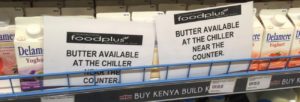
It was interesting to note recently that there were several Facebook posts made to the Nairobi Expats Group posing the very same question – where can one find butter in Kenya? It was even more fascinating to discover that the butter blocks have moved from its usual freezer shelf into a locked cupboard near the front counter at our local supermarket. As expats are hunting out for butter in cakes, some locals complain resentfully that the implications of drought in the country are not well-understood.
Indeed, price of dairy products has skyrocketed as a result of the ravaging drought that has hit major milk producing zones in Kenya. In reports published last year, Kenya’s milk prices stands to be second most expensive in Africa after South Africa. Since then, milk prices have further increased 20-25% over the course of half a year. The dairy industry and its high pricing have long been criticised by locals due to lack of market competition. The well-known dairy company, Brookside, controls more than 50% of the Kenyan processed milk market. Remarkably, it is also known that the Kenyatta presidential family owns a majority stake holding within this company.
Unfortunately, the high prices of Kenyan packaged milk have pushed most poor homes in urban towns into the hands of raw milk hawkers who charges less, despite being banned over safety concerns. Innovative farmers have also started keeping camels for milking, whose milk never dries up in comparison. East Africa is home to 60% of the world’s camels and the largest market for camel milk which local consumptions is ever-increasing. As a result of the devastating drought, “camelcinos” – a cappuccino made with camel milk, has also made its way onto many café menu in Nairobi!
“With enough butter, anything taste good” is a famous saying in the western kitchen. Unfortunately, with the milk and butter scarcity, cakes in Kenya may also need to start taking an innovative form like cappuccinos!